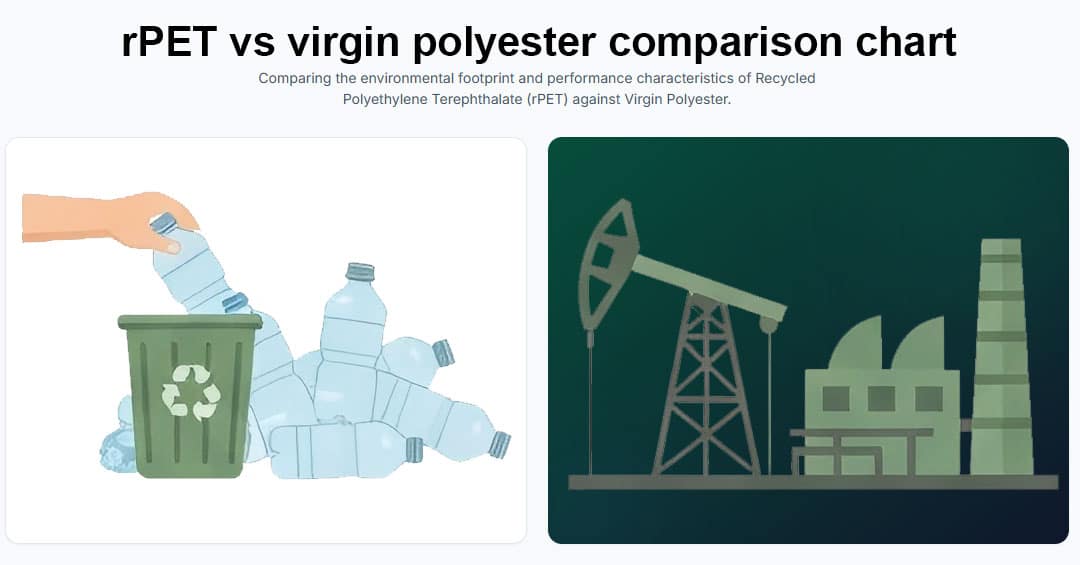rPET vs Virgin Polyester: Performance, Cost & Eco Impact Comparison
Polyester has been the dominant fabric for backpacks for decades due to its durability, cost-efficiency, and versatility. With sustainability becoming a priority for global brands, rPET (recycled polyester) has emerged as the preferred alternative — but how does it really compare to virgin polyester in performance, price, and environmental impact?
As a Chinese backpack manufacturer working with both virgin and rPET materials, this guide provides a clear, factory-level comparison to help sourcing managers, designers, and brand buyers make informed material decisions.
Quick Summary — The Key Differences
rPET matches virgin polyester in mechanical performance but requires more complex recycling steps, resulting in slightly higher material cost. Its environmental benefits — reduced CO₂ emissions, lower energy usage, and waste reduction — make it a strong choice for brands with sustainability targets.
1. Performance Comparison
Modern rPET yarns are engineered to match the tensile strength, tear strength, and abrasion resistance of virgin polyester. When pellet IV (intrinsic viscosity) and spinning parameters are strictly controlled, final fabric performance is almost identical.
Mechanical Performance
- Tensile Strength: Comparable when IV is 0.70–0.80.
- Tear Strength: Depends on yarn denier and weave, not material type.
- Abrasion: rPET performs equally when using high-quality pellets and DTY yarn.
Color Performance
rPET dye uptake is slightly more sensitive to pellet quality. Mills with strong filtration and decontamination deliver color uniformity similar to virgin polyester. ΔE control (<2.5) is critical for large-volume packs.
Appearance & Handfeel
- Premium rPET appears identical to virgin polyester.
- Low-grade rPET may appear slightly yellowish.
- Both can be woven into 300D/600D/900D/1200D textures.
2. Cost Difference — Why rPET Is More Expensive
rPET is typically 5–20% more expensive than virgin polyester, depending on global bottle recycling supply, TC (Transaction Certificate) requirements, and dyeing difficulty.
Why rPET Costs More
- More complex production: collection → washing → flake → chip → yarn
- Higher energy required for decontamination
- GRS certification & documentation cost
- Market demand from apparel & outdoor brands
Cost Trends
When oil prices are low, virgin polyester becomes cheaper, widening the cost gap. When sustainability regulations tighten (EU/EPR), rPET becomes more competitive.
3. Environmental Impact — Where rPET Wins
The strongest differentiator between rPET and virgin polyester is sustainability. Virgin polyester relies entirely on petroleum extraction, while rPET reduces landfill waste and lowers greenhouse gas emissions.
- CO₂ reduction: ~45–70% lower than virgin polyester.
- Energy savings: ~30–50% lower depending on recycling system.
- Waste reduction: Reuses PET bottles, diverting them from landfills/oceans.
4. Certifications & Traceability
Virgin polyester requires no certification but also provides no sustainability claims.
rPET depends heavily on certified supply-chain traceability:
- GRS Certification — the most recognized standard
- TC (Transaction Certificate) — required for each batch
- Chain of custody — bottle → flake → chip → filament → fabric
Without a TC, brands cannot legally claim recycled content.
5. Best Uses in Backpack Manufacturing
Both rPET and virgin polyester work well for most backpack categories, but sustainability goals and target audience usually drive the final choice.
Where rPET Is Ideal
- School backpacks & lifestyle bags
- Outdoor daypacks (300D / 600D rPET)
- Travel packs and accessories
- Brands with sustainability KPIs
Where Virgin Polyester Still Makes Sense
- Ultra-budget retail price points
- High-volume promotional backpacks
- Heavy-duty industrial/military bags (usually 900D/1200D virgin)
Factory Notes — Practical Tips for Buyers
- Request GRS TC certificates early to avoid shipment delays.
- Check colorfastness carefully for dark shades (navy/black).
- Plan 10–20% longer lead times for certified rPET batches.
- Expect price fluctuations based on global bottle collection supply.
- For outdoor packs, specify TPU lamination for waterproof performance.
FAQ
Does rPET perform as well as virgin polyester?
Yes. High-quality rPET matches virgin polyester in strength and abrasion resistance when IV and spinning processes are controlled.
Why is rPET more expensive?
The recycling and certification process is longer and more complex, increasing the overall cost.
Is rPET always more sustainable?
Yes, when sourced from certified suppliers. rPET significantly reduces CO₂ emissions and diverts plastic waste from landfills and oceans.
